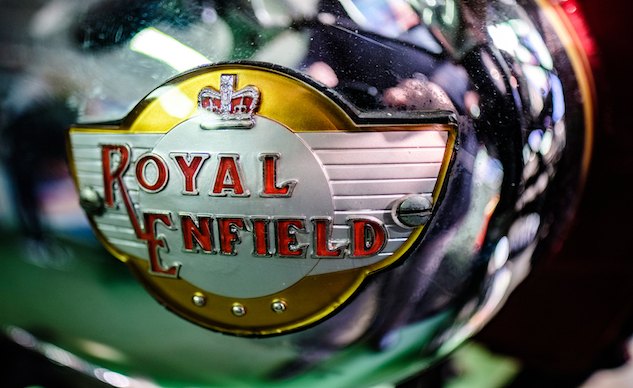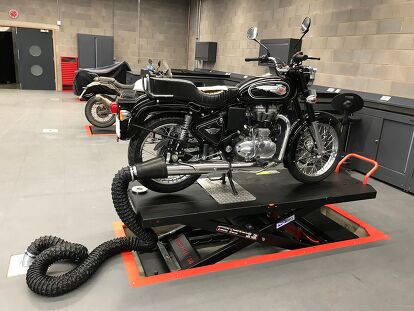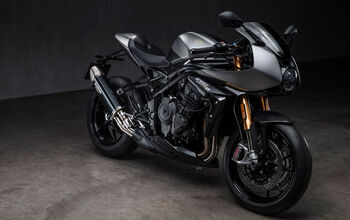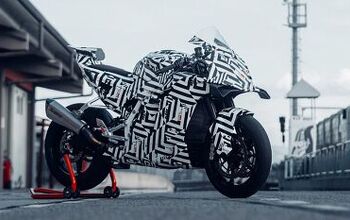Royal Enfield's UK Technology Center Tour
We go inside the Indian company's English development facility
Thomas R. “Big Tom” Callahan, Jr., an auto parts salesman from Sandusky, Ohio, once said, “You can get a good look at a T-bone by sticking your head up a bull’s ass, but wouldn’t you rather take a butcher’s word for it?” When it comes to steak, we at MO would be inclined to heed the butcher’s advice, but when it comes to motorcycles, we’d prefer to take that “deeper” look to see for ourselves…
Royal Enfield invited us to take a comprehensive behind-the-scenes look into its UK Technology Center in Leicestershire, England. There, with the collaboration from the Chennai, India factory, they have designed, engineered and tested two all-new from-the-ground-up models that both feature the new 650 parallel-Twin motor. These new models include the Interceptor INT 650 and the Continental GT 650. While there, we were able to speak with several of Royal Enfield’s reps, including all the top dogs, and gain further insight into the company and its new products.
Royal Enfield may not be the household name in America like it is in many other parts of the world. So, to give a little background on the company, Royal Enfield is not only the oldest motorcycle manufacturer in continuous production since 1901, but it’s also the fastest-growing motorcycle brand in the world, as well. Royal Enfield has grown 16-fold in the last eight years. The company has gone from building 50,000 units in 2010 to more than 800,000 by the end of this year and is aiming to produce 950,000 units next year. Royal Enfield’s sales are equivalent to the global sales of Harley-Davidson, KTM, BMW, Triumph, and Ducati, combined. Let that sink in for a second.
What’s most interesting and unique about Royal Enfield is the approach it has taken to become this global heavyweight motorcycle manufacturer. It’s important to make clear what Royal Enfield is, and what it isn’t. Siddhartha Lal, Royal Enfield’s CEO, explicitly states that the company isn’t interested in making high-performance sport bikes or big-displacement cruisers. But rather, it’s chasing after the middleweight market, specifically the 250-750cc segment. For years now, Royal Enfield has been making 350 and 500cc variants of its Classic, Bullet and Thunderbird models, along with the 535cc Continental GT café racer. However, there hasn’t been a larger-displacement bike to upgrade to since 1970, when Royal Enfield stopped making its 736cc Interceptor.
Enter the all-new 650 Twin. It’s a 648cc air/oil cooled parallel-Twin with a single overhead cam and four valves per cylinder. These features combined with a 9.5:1 compression ratio yield a claimed 47 horsepower at 7100 rpm, with about 39 ft.-lbs. of torque waiting at just 4000 rpm. These output numbers won’t make you the king of your local drag strip, but that’s not what Royal Enfield is about.
“Royal Enfield aims to lead and expand the middleweight segment globally,” Lal told us about why RE chose to make the 650 Twin. “While the new 650 Twins will be a compelling upgrade for our large customer base in India, we believe they will attract customers from other developing markets in Southeast Asia and Latin America to graduate to the middleweight segment as well.”
Unlike here in the United States, where many believe there’s no replacement for displacement, developing markets in the rest of the world don’t have a need for such big-bore bikes. In many cases, the roads just simply don’t allow for it. On top of that, certain countries’ governments either restrict engine size or make it very difficult to own large-displacement bikes by implementing steep import tariffs or luxury taxes. For example, learners in Australia are restricted to a motorcycle with a motor no bigger than 660cc for their first two years. In Indonesia, some provinces have import taxes on large-displacement motors starting at 30-40%, and tariffs in Malaysia can be hiked all the way up to 125%.
Royal Enfield reps say they’re out to capture the consumer, not the competition. They’re here to grow the market, not steal other manufacturer’s customers, although that might end up being the case. At the core of Royal Enfield’s goals, more than anything else is to provide motorcycles that are versatile, fun, agile and yet unintimidating and accessible – the key words here being, fun and accessible because that’s what CEO Siddhartha Lal and RE President, Rudratej (Rudy) Singh believe motorcycling is all about.
Now, before all you middle-aged guys holding onto your 15-year-old R1s (who, mind you, aren’t buying new motorcycles anymore) start typing away in the comments section writing off Royal Enfield by complaining that these new bikes are ugly and grossly underpowered, understand this: These bikes aren’t designed for you. Instead, young, urban riders – many of whom are women – are the key demographic to motorcycle growth right now. More and more young people are flocking to cities, where not only is the cost of living higher, but also navigating the urban sprawl is becoming exceedingly difficult and time-consuming. This is where a fun and affordable motorcycle begins to become attractive to a learning rider. This is a big segment of the market that Royal Enfield is after.
Giving budding riders a unique option is not just reserved for young people, although I imagine the new Royal Enfields will pique their interests. The new engine also answers the call of Royal Enfield loyalists who have long yearned for more mid-range torque and top speed from the traditionally styled bikes. In the past, especially in America, the 350, 500 and even top-spec 535cc (29hp) Continental GT models haven’t cranked out enough power to comfortably ride in modern, high-speed traffic conditions (And vibrated to annoying levels…-Ed.), so the new counterbalanced 650cc models will help remedy this situation.
There should be a lot of inherent value built into the new Royal Enfield motorcycles for a variety of reasons: They’re approachable in the sense that they’re unintimidating motorcycles. They’re simple in the sense that if you need to work on them, you can easily do so without the hassle of removing multiple body panels to access whichever components need attention. Their basic engineering makes them authentic in the sense that they’re not a replica, recreation or knock-off of some other style bike that was once popular. Royal Enfield has been around for a long time and it has stayed true to its heritage and has stuck to its guns (pun intended, as RE was once a gun manufacturer). And, finally, they’re affordable. The Interceptor INT 650 will cost about $6,000, according to hints from RE reps, and the Continental GT 650 will only be a few hundred more at around $6,500.
If classic roadster or café racer styling isn’t your cup of tea, Royal Enfield is also offering the Himalayan, a more adventure worthy bike with off-road capability. Some of its features include a single-cylinder, fuel-injected, 411cc air-cooled motor, 21- and 17-inch wheels, almost eight inches of suspension travel front and rear, and plenty of room and mounting points for hard and/or soft luggage. The Himalayan is currently Royal Enfield’s most versatile motorcycle and should take you from the beaten paths of the city, off the grid and into the wild. And at $4,499, it will keep your wallet happy too.
Of course, there are plenty of other, more sophisticated, more powerful bikes out there that will blow the doors off of any Royal Enfield in terms of performance. But, like we mentioned earlier, the company is not out to compete with the high-tech, high-performance machines other manufacturers are making. RE is in the business of selling passion with the mantra less is more.
Above all else, what makes Royal Enfield’s approach to selling motorcycles interesting is that it’s essentially striving to build the Toyota Camry or Honda Civic of motorcycles – relatively simple and cost-effective vehicles that can serve the duties of most buyers. This is in no shape or form an insult of any sort, because there’s one of these cars in just about every other driveway in America…
The new twin-cylinder Royal Enfield models are expected to hit the States and become available to the public sometime in April, about a month after we get to throw a leg over the Interceptor INT and Continental GT 650 during its launch in March. It will be interesting to see how these models stack up against the significantly more expensive Triumph Bonneville lineup of bikes that begin with the $9,100 Street Twin and rise up to $13,000 for a Thruxton. While looks and performance are obviously important, so is price.
We’ll see how this strategy works out for them. If Royal Enfield’s global performance is any indicator, we expect RE’s strategy to make waves Stateside, too.
More by Brent Jaswinski





































































Comments
Join the conversation
Interesting that the article doesn't mention that Royal Enfield "created" their UK technology center by purchasing Harris Performance in 2015.
"Siddhartha Lal, CEO of Royal Enfield confirmed the deal this afternoon, saying 'All of the current staff at Harris Performance will now become employees of Royal Enfield, taking responsibility of performance and development engineering for our new range of motorcycles. They will be part of Royal Enfield’s upcoming UK Tech Centre'."
http://www.motorcyclenews.c...
OK, where are the dammed cats, or the dismal air injection? Government can't stand this, it's too cool. I can dream though, pre CARB and the EPA. Musn't foul the air with our minuscule contribution. The elites are soooooo sensitive.